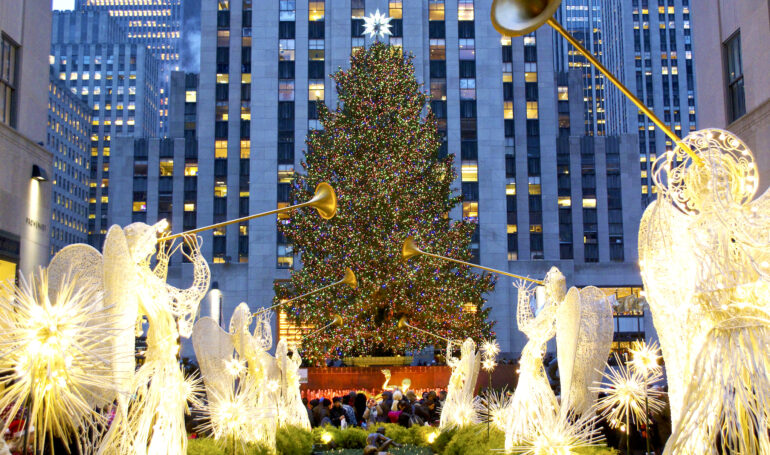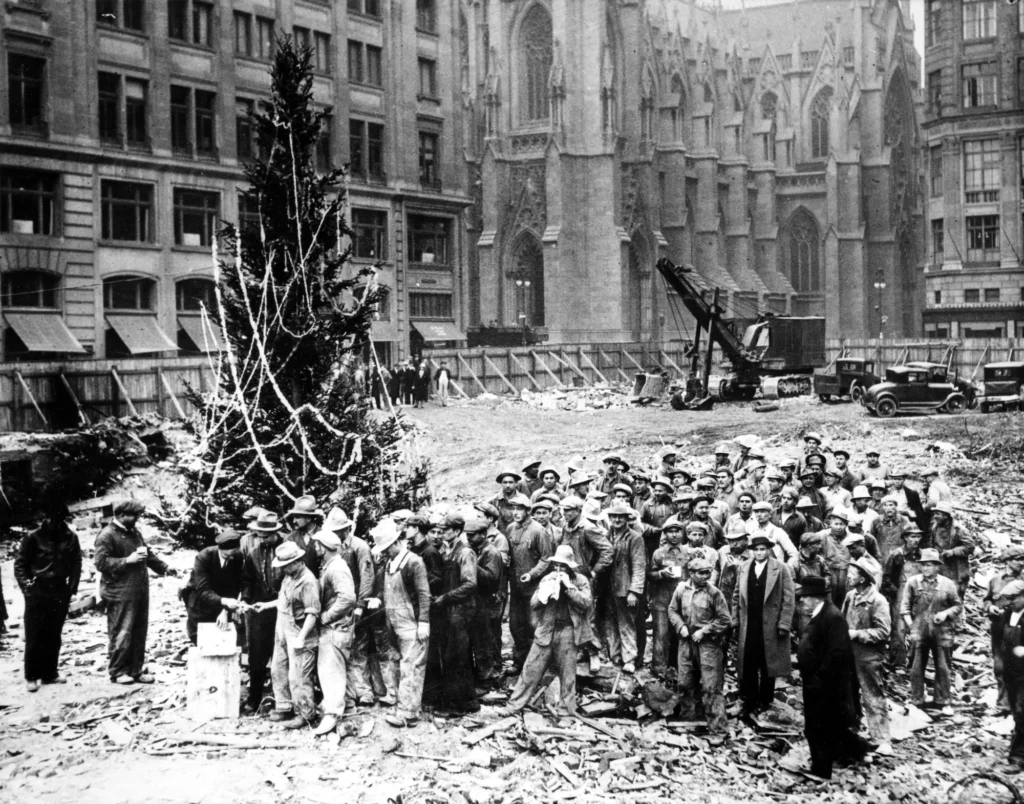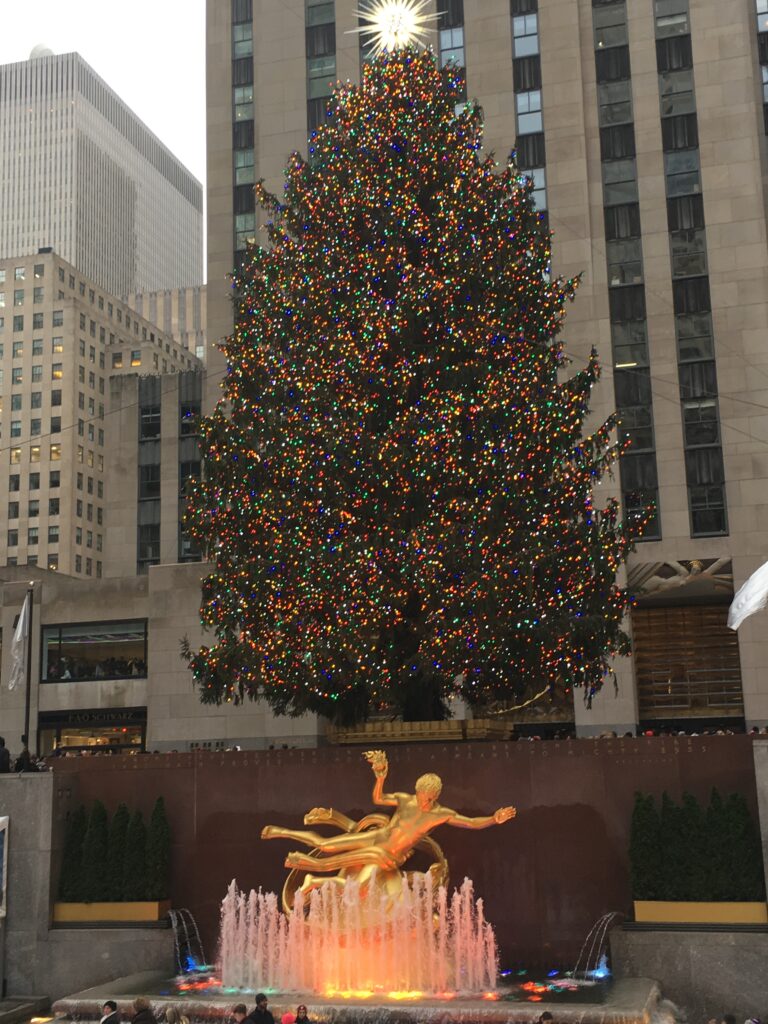
The Italian Influence Behind the Rockefeller Christmas Tree
Perhaps you, like me, watched the Christmas tree lighting ceremony of the famous Rockefeller Christmas Tree this past week. What you might not have realized is that we have Italian immigrants to thank for this almost century old tradition.
The Rockefeller Center Christmas Tree stands as a beacon of holiday spirit in New York City. It attracts millions of visitors annually. For a number of years, my family and I would visit New York City on the first week-end in December to see the amazing display. While the dazzling lights, towering stature, and grand setting of the tree might seem quintessentially American, the tradition owes a significant debt to Italian influences. From the immigrant craftsmen who played a pivotal role in its origins, to the Italian artistry that inspired its aesthetic evolution, the Rockefeller Christmas Tree is a living homage to Italian culture and its contributions to America.
The Humble Beginnings: Italian Immigrants and the Depression-Era Tree
The tradition of the Rockefeller Christmas Tree began during the Great Depression in 1931. That year, a modest 20-foot balsam fir was erected on the construction site of Rockefeller Center by Italian immigrants who had worked on location. The Italian construction workers had come to America seeking better opportunities during a time of economic hardship. The tree was their way of thanking the city for the work they had during such difficult times. They decorated the tree with homemade garlands, tin cans, strings of cranberries, and even paper. A stark contrast to the glittering spectacle it has become today.
These workers, steeped in Italian traditions of celebration and family, were no strangers to the symbolic significance of the Christmas tree. In Italy, while the presepe (Nativity scene) is the centerpiece of holiday decor, trees were also part of festivities, particularly in Northern Italy. The workers likely saw the tree as a way to bring a touch of home to a foreign and challenging environment. In turn, fostering a sense of community and hope amid uncertainty.

Picture Credit: Tishman Speyer.
Italian Craftsmanship and Rockefeller Center
Italian immigrants were not just workers at the Rockefeller Center construction site, they were also master craftsmen. Their skills in stone carving, mosaic work, and architectural detailing left a permanent imprint on the Center’s aesthetic. This craftsmanship was instrumental in creating the opulent backdrop against which the Christmas tree would later stand.
The towering Art Deco style of Rockefeller Center, with its intricate carvings and grand public spaces, echoes the Italian Renaissance tradition of creating spaces that celebrate both art and community. These influences helped establish Rockefeller Center as more than just a commercial hub. It became a cultural landmark, ideal for hosting a monumental symbol like the Christmas tree.
The Italian Renaissance and Rockefeller Christmas Tree Design Inspiration
As the Rockefeller Christmas Tree tradition evolved, so did its design and decoration. Much of this transformation can be traced back to Italian artistic principles. The Renaissance, a movement that began in Italy, emphasized balance, symmetry, and grandeur. All qualities that became hallmarks of the Rockefeller tree.
The tree’s lights, often numbering in the tens of thousands, reflect the Italian love for luminosity during festive celebrations. Cities like Florence and Venice are known for their brilliant holiday light displays. And it’s no stretch to imagine that these traditions inspired the dazzling illumination of the Rockefeller tree.
Moreover, Italian glassblowers from regions like Murano have long been renowned for creating intricate ornaments and decorations. Although the Rockefeller tree initially featured simpler adornments, it eventually embraced more elaborate designs. Designs reminiscent of the exquisite craftsmanship seen in Italian holiday decor.
The Star: A Nod to Italian Artisanry
One of the most iconic elements of the Rockefeller Christmas Tree is its crowning star. Since 2004, the tree has been topped with a Swarovski crystal star, a masterpiece of craftsmanship and engineering. While Swarovski is an Austrian brand, the concept of adorning a tree with a luminous star has roots in Italian Christmas traditions.
In Italy, the “stella cometa” (comet star) is a central figure in Nativity scenes. It symbolizes the Star of Bethlehem that guided the Magi. This connection underscores how Italian cultural symbols have permeated the Rockefeller tradition, even if indirectly. The craftsmanship of the star also recalls the Italian dedication to blending art with function, seen in everything from cathedrals to jewelry.

Picture Credit: Lazy Italian Culinary Adventures
Italian-American Celebrations and Cultural Preservation
Throughout the 20th century, Italian-American communities played a significant role in shaping American holiday traditions. Italian immigrants brought with them a rich tapestry of customs, including elaborate feasts, religious observances, and decorative artistry. These traditions often merged with American practices, creating a unique blend of cultural expression.
The Rockefeller Christmas Tree became a focal point for this blending of traditions. Italian-Americans, who were integral to New York’s cultural fabric, embraced the tree as a symbol of unity and celebration. Their influence can be seen in everything from the tree’s grandeur to the musical performances that accompany its lighting ceremony, many of which include Italian-American performers and operatic pieces.
Sustainability and the Italian Connection
In recent years, the Rockefeller Christmas Tree has also embraced sustainability, a concept deeply rooted in Italian culture. Italy’s agricultural heritage emphasizes respect for nature, a principle echoed in practices like sourcing the tree responsibly and recycling it after the holiday season.
The wood from the Rockefeller tree is often donated to organizations like Habitat for Humanity, embodying a spirit of giving that aligns with Italian values of community and charity. This modern iteration of the tradition demonstrates how the Rockefeller tree continues to evolve while honoring the timeless principles that Italians have long cherished.

Picture Credit: Lazy Italian Culinary Adventures.
The Rockefeller Christmas Tree as a Symbol of Resilience
The story of the Rockefeller Christmas Tree is ultimately one of resilience. A theme that resonates deeply with Italian history. From the Roman Empire to the Renaissance, Italy has a long tradition of overcoming adversity through creativity and unity. Similarly, the Rockefeller tree began as a beacon of hope during one of America’s darkest periods. It has since grown into an enduring symbol of holiday joy.
Italian-Americans, who faced discrimination and hardship upon their arrival in the United States, found ways to integrate their heritage into American life. The Rockefeller Christmas Tree stands as a testament to their contributions, blending Italian artistry and values with American traditions.
Conclusion
The Rockefeller Christmas Tree may be a distinctly American icon, but its roots are deeply intertwined with Italian culture. From the immigrant workers who erected the first tree to the artistic principles that shaped its evolution, the Italian influence is undeniable.
Each year, as the lights are switched on and the tree illuminates Rockefeller Center, it serves as a reminder of the enduring impact of Italian artistry. And also of its craftsmanship, and tradition. In its grandeur and symbolism, the tree captures the spirit of a holiday season. It celebrates unity, resilience, and the blending of cultures. A legacy that Italians helped shape and that continues to inspire millions around the world.
Leave a Reply

What to Pack for Italy
Cosa Mettere in Valigia per l'Italia
Everyone is always asking me what they should pack for Italy,
so I’ve created a quick reference guide that you can use for your next trip.
Hint: You don’t need nearly as much as you think you do!

6 Comments
Thank you for the history.
Thank you Francesca for the very informative article about the origins of the Rockefeller Center Tree.
Reading your story about the history of the Rockefeller Christmas was truly heartwarming and so lovingly expressed! Thank you!
I treasure the fact that I am a decedent of Italian heritage; I’m proud to be part of such culture because my grand parents came to the US in early 1900’s and started businesses and raised their children to be proud citizens of the USA. It saddens me that some US politics are pushing the thought, belief or concept that all immigrants are a bad influence and they have a negative influence on our county. People that believe that should read your article! It is especially touching during this holiday season of celebration and giving to others. My Sundays wouldn’t be right without an Italian dinner with family. Thank you!
So nice to hear about this Italian legacy. Thank you and Merry Christmas.
Thank you ,grazia tanto ,I just cried reading this article … so heart warming beautiful memories of my mom and dad . Is there a book or a document that I can purchase with this amazing history even though we are not American . My dad’s 7 siblings came to America ,my dad was the only one that came to Canada. I am Italian from Girifalco provincia di Catanzaro and came to Hamilton Ontario at the age of 8 . I remember visiting Connecticut many times and our aunts and uncles talking about the Christmas tree . Francesca not only amazing cuisine but amazing historian . The best Christmas ever you gave me .
Ciao Rose, I’m so happy to receive your message. Not sure if you know, but I am from Palermiti, we’re neighbors with Girifalco! I came to the US when I was almost 11, so not much older than when you made your move. Thank you for reading the article and I hope our paths cross some day! Hopefully in Italy!